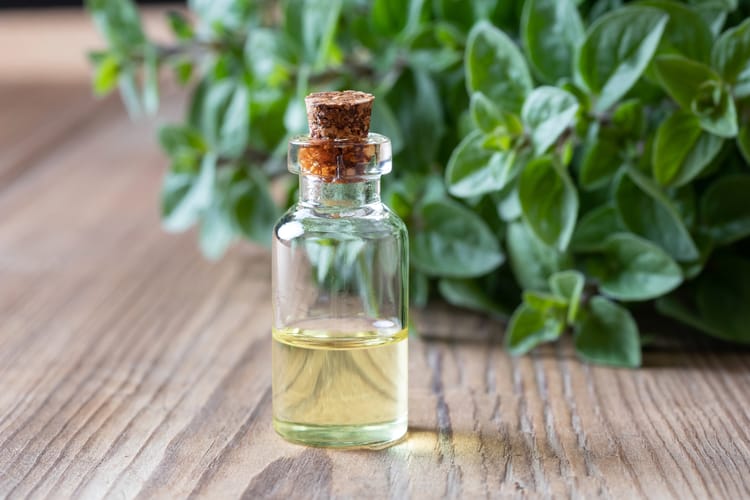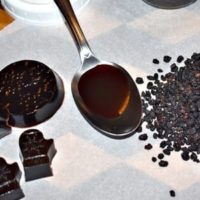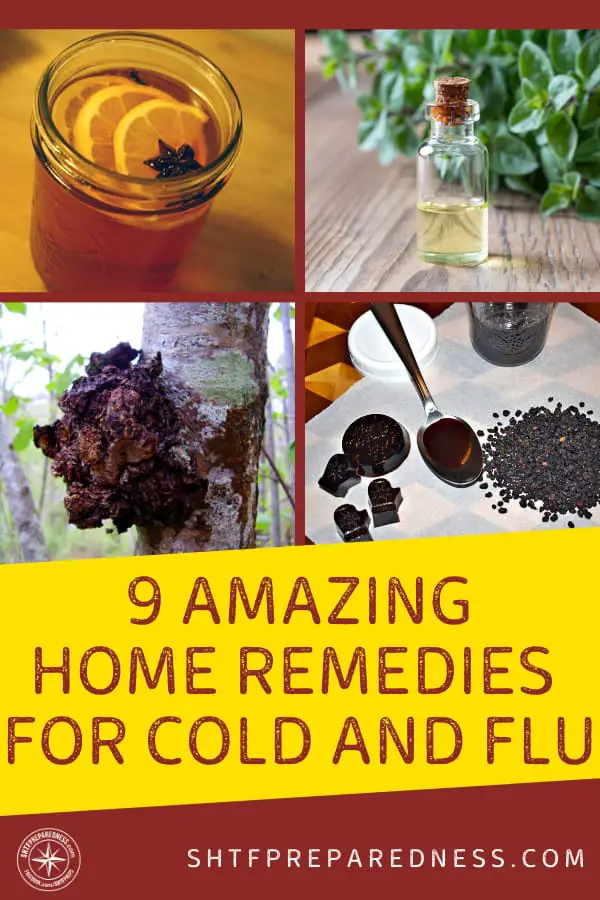That initial scratch in the throat or the first aches in the joints should send you running for the closest home remedies for colds and flu.
Unfortunately, those first signs lead to worse symptoms, which then lead to those direr symptoms. Eventually, you are down for the count, waiting for the virus to run its course.

While not as debilitating as some of the sexier injuries, the flu will take you out of the fight just as quickly.
Therefore, as soon as you notice things going south, head for the kitchen and cook up one of these home remedies for a cold. Nip it in the bud and get back to managing your new normal of the apocalypse.
When to See a Doctor
There are far worse things than a cold or the flu. A stuffy nose and head congestion don’t quite have the weight of a traumatic amputation; however, they are still not trivial matters.
Left to fester, the list of possible complications is long. Worse, if the source of your or your loved one’s cold is bacterial, then it simply is not going away on its own.
When society is operating normally, you must seek proper medical care as soon as possible.
Leaving symptoms untreated or treated at an inappropriate level all because you wish to try a home remedy for a cold is inviting complications and an unnecessarily long recovery. If you are sick, pay your doctor a visit.
When the doctor is in, stop by and get a proper diagnosis and script. If and when the balloon goes up, use every tool at your disposal to accomplish a complete and full recovery. This includes home remedies.
Colds, Flus, and Viruses, Oh My!
Nothing makes my wife threaten to call the ambulance on me quicker than a runny nose. Apparently, I do not suffer in peace.
Then again, that’s her interpretation; I personally think I have the strength of Sampson.
Regardless of your internal fortitude, colds suck. You leak, you ache, you cough, and while sleeping, you snore like a congested heifer. It’s hard to embrace the suck when you can’t be farther than 3 feet from a box of tissues.
All this from a bug you probably picked up on some handrail. Equally likely, your child brought the contagion home from that petri dish called school.
Let’s take a look at the makeup and causes of the common cold and flu.
What’s a Virus?

Both colds and flu are caused by viruses.
Not to get all technical, but a virus is dramatically different from bacteria. First and foremost, viruses aren’t quite alive.
Viruses live by infecting larger living organisms, invading individual cells, stealing genetic information, and then replicating.
Bacteria, on the other hand, undergo mitosis (cell division), splitting themselves in two at reliable intervals.
Antibiotics work on bacteria, not viruses. For most cold and flu viruses, your only recourse is to let them run their course.
Let’s look at how these little demons interact with our lives.
How Do You Pick up a Virus?
As stated above, a virus requires a living cell in order to replicate and live. To get into the cells of your body, you must first encounter one in the wild. There are two main options.
Viruses on Surfaces
While a virus thrives inside the cells of its host, its life is not limited to this existence. Most viruses can live for a short time outside of a host. In general, flu viruses can live for about 48 hours on a surface.
Comparatively, cold viruses have a “shelf” life of fewer than 12 hours.
48 hours is an eternity in most public spaces. Bathrooms, lunchrooms, and even stairwells can encounter thousands of different people in 48 hours. Each providing the opportunity to deposit (or pick up) a wee little traveler.
In the span of 12 hours, handprints will cover most surfaces in a public space. Consider that only 5% of people properly wash their hands after using the bathroom. Can you guess the number that comes after a cough, sneeze, or even a subtle nose pick?
Yup life is gross. During the peak of the cold and flu season, just stay home if you’re anything like me.
If you do go out, channel your inner Howard Hughes or Howie Mandel and don’t touch anything. If you are forced to grab a handrail, wash, rinse, and repeat. Hand sanitizer is your best friend.
Death from Above: The Cough and Sneeze
Almost as gross as the things we touch is the air we breathe. Especially in populated and confined spaces.
Considering the average sneeze travels at 70 miles per hour and the 3,000 droplets (!) within a cough travel 25 feet, it’s a wonder that any of us survive winter.
Modern research has found that the flu virus is airborne. As you cough, blow your nose, and sneeze, tiny droplets loaded with viral hitchhikers sail merrily around on the air currents, looking for their next host.
After surviving+3 hours in the floating droplets, there are ample opportunities for that droplet to be recycled when someone else happens by and takes a deep breath.
Think of this the next time you’re at the mall, or DMV, or library, or airport, or bus station, or train station, or airplane, or work, or…
Cold and Flu Symptoms
So, you ventured out into public, touched a table, and took a deep breath. How do you know if you have a cold or flu?
The good news is that there are several reliable symptoms that will help identify the sniffy, drippy, path ahead. Learn these symptoms so that you can start your home remedies for cold and flu early before things get out of hand.
Cold Symptoms
The start of a cold is usually indicated by a sore throat, cough, and runny nose. Add in sinus congestion and flow of mucus and you are firmly in the cold territory.
For children, low-grade fevers accompany the above symptoms as well as slight body aches and a mild headache. Within 7–10 days, adults and kids are on the path to recovery.
Warning, you are most contagious for the first 3 days. Avoid close contact with others, cover your nose and mouth when you sneeze. Wash your hands often during this time.
If the symptoms continue beyond 10 days, the cold is most likely bacterial and not viral. For these infections, see a doctor and get on a course of the proper antibiotics.
Flu Symptoms
The primary difference between the flu and a cold is that flu symptoms come on stronger. The congestion, coughing, aches, and pains all hit faster and harder.
Secondly, headaches, muscle aches, and exhaustion accompany the flu. Oftentimes they get better, then reverse and get worse before recovery starts.
Similar to a cold, the flu is most contagious for the first 3–4 days. Again, stay home and rest for 7–10 days, and you’ll be right as rain.
From Bad to Worse
If symptoms remain untreated, your cold or flu will go from bad to worse. The congestion in your chest and hours of coughing bring on bronchitis. The associated wheezing and shortness of breath will extend the time off your feet.
Treat the symptoms before things get worse.
A little farther north, congestion in your head leads to both sinus and ear infections. The pressure associated with a sinus infection is no joy and can lead to debilitating headaches and pain.
Likewise, an ear infection not only leads to pain and fever but may also affect your balance. Vertigo is unpleasant in normal times.
The inability to balance during SHTF will be beyond miserable, and you may not have the option to forgo daily tasks.
To the Doctor?
Colds and the flu are harmless enough that few of us even go to the doctor for treatment. The standard approach is to work with the symptoms, rest, and get back into the fight as soon as possible.
Decongestants, pain/fever reducers, and rest represent the standard medical approach for cold and flu symptoms.
Decongestants reduce and loosen up mucus in your head and chest. They slow down the flood, allowing the rest to be blown, coughed, and spit up in copious amounts.
Tylenol and Ibuprofen work on both the pain and any low-grade fever.
Allowed to progress, or when symptoms lead to other complications, doctors prescribe antibiotics for any secondary infections.
If you are able to catch the symptoms in the first few days, your doctor may prescribe an antiviral medication like Tamiflu. These drugs shorten symptoms by a few days.
Home Remedies for Colds and Flu
If your patient is very young, very old, or has a compromised immune system, seek qualified medical care immediately.
While for most of our lives we can just brush off the sniffles, the most vulnerable may not have this option. Secondary infections may be too much to handle. Seek a doctor first.
For the rest of us, self-treatment is the norm for colds and flu. Treating the symptoms and providing comfort is the realm of mothers, grandmothers, and other caregivers around the globe.
Chicken soup and a day off from work or school will do wonders in most cases. If this is your world, let’s look beyond the soup and bed.
1. Vitamin C

Recently proven to boost the immune system, vitamin C is a great addition to your diet. Take daily as tablets with your orange juice. Or, if you’re hardcore, sprinkle a few vitamin C crystals in a drink (warning, it tastes like bile).
To go a little more natural, add foods high in Vitamin C to your diet. Oranges, tomatoes, and chili peppers are common Vitamin C boosters.
Rosehips, parsley, thyme, and even white pine needles are all loaded with Vitamin C and great home remedies for a head cold.
For those not interested in thyme spiced pine needle tea, try a warmed glass of lemonade. Sweetened with a touch of honey, it boosts your Vitamin C intake as well as soothes a sore throat.
Add it to your daily routine; however, increase your dosage when symptoms first present themselves.
2. Chicken Soup

Not just the stuff of old wives’ tales, chicken soup is a great go-to home remedy for a head cold. It is warming, soothing, and easily digestible.
Comforting to the throat while the steam clears the sinuses. Finally, the nutrients provide energy for the internal fight going on.
3. Ginger Tea

Ginger is well known as a “warm” spice-filled to the brim with healing properties. Gingerol, the source of the sharp taste in ginger, provides the anti-inflammatory and antibiotic properties in this home remedy.
Boil several slices in 2 cups of water, then let cool to a drinkable temperature. Boost with a slice of lemon and some honey to aid in soothing the throat.
4. Saltwater Gargle

fermicat via flickr
Great for sore throats, canker sores, and tooth infections, a saltwater gargle has been one of the go-to home remedies for colds, sore throats, and mouths for generations.
Mix 1 tablespoon of salt with 1 glass of water (it should taste like seawater) and gargle for 30 seconds. Do not swallow. The saltwater will provide temporary relief of your mouth and throat pain.
5. Garlic

Personal storytime.
I traveled internationally one winter, from December through March. It seemed as though each month I was on a different continent (not quite but close). All that time in airplanes and in dry hotels kept me in a constant state of a head cold.
Frustrated with the lack of progress I was making with my treatment for flu-like symptoms (I was out of Chaga, see below), I encountered grandma’s cure-all. Garlic!
Twice per day, for three days, I did the following:
- Crush one (1) large clove of garlic to a fine paste.
- Allow to “activate” (oxidize) on the counter for 20 minutes.
- Eat the paste raw.
- Chase with a glass of water.
Morning and night, I kept the vampires away.
On the second day, I felt on the proper side of normal for the first time in three months.
By the morning of the fourth day, I was 100 percent.
I have since repeated this whenever I feel a cold is tipping past annoying. I have yet to have a cold or flu take hold of this routine.
6. Oregano Oil

Like many of the other old standbys, Oregano contains many healing compounds. Extracted as an oil, it packs a big punch in a small package by providing anti-inflammatory, wound healing, and anticancer properties.
When you feel the symptoms of a cold settling in, add 5–10 drops of oregano essential oil to a small amount of water, swish it around your mouth for 30 seconds, then swallow.
This process coats the capillary-rich mucous membranes of your mouth with oil and facilitates rapid absorption.
Repeat 3–4 times per day.
7. Chaga

Mushrooms are true wonders of God’s creation. They rid us of the detritus of our world, provide food, and offer unsurpassed natural medicines.
Chaga (Inonotus obliquus) grows on birch trees and is a combination of the roots (mycelium) of the mushroom and the scar tissue of the tree.
Commonly called the clinker polypore, it looks like a chunk of creosote on the side of the tree. It’s hard as a rock and usually harvested with an ax or stout machete.
Ground into a coarse powder and brewed into tea or made into a tincture, Chaga is a powerful anti-inflammatory and immune booster. The tea tastes reminiscent of maple sap (not syrup).
When taking the tea, have a glass or two each day while you are feeling under the weather. Use as a tonic once per day when you are feeling fine to keep the nasties away.
I make and take my own tincture. Aside from the anecdote above, I haven’t been seriously sick for over 5 years—the same time that I’ve added Chaga to my routine.
8. Boilo

Time to go deep into the backwoods. It seems as though every culture has its own version of a medicinal hot toddy. The coal region where my ancestors are from is no different.
Boilo is the hottest of hot toddies. It starts by boiling water, honey, cloves, cinnamon, lemon slices, and orange slices (each family has its own exact mixture). Once you have boiled the hell out of that, cool and add a quart of the cheapest whiskey you can find.
Drink a small glass while still warm and seal up the rest in an old pint jar. Warm, drink, and repeat until your symptoms subside (or you no longer care).
It should be self-evident that this is one home remedy for a cold and cough, not to be used on infants or while pregnant.
The honey, cloves, cinnamon, and citrus provide antibacterial, antiviral, and anti-inflammatory cocktail that offers Vitamin C to boot. The whiskey adds a touch of “I don’t care about the rest of the problems of the world” as well.
In my family, boilo is taken when symptoms set in to the point of confining you to a chair for the rest of the day. It is taken liberally when returning from a long, cold day hunting in the woods, but, I digress.
To make our favorite recipe for “Boilo, the Traditional Yuletide drink of the Coal Region,” go to Coal Region Recipes.
Bonus: Russian Tea
Coming in just behind boilo on my list of favorite cold and flu remedies is honorable mention: Russian Tea.
The origins of Russian tea are pretty straightforward. It’s a great recipe that has some of the working parts and pieces of other drinks (like boilo!).
While it’s not only a great healing “potion,” it’s also a delight to drink! Designed for the cold and flu seasons, this drink would be just as refreshing in the summer months.
This is not a recipe that was just created because it’s hip or cool. Instead, we are dealing with a natural healer that has been used to deal with things like the flu and colds.
Add this to a tremendous list of recipes that you can call on and make yourself. These natural healers are supposed to be part of our lives. OTC medicines pushed them out of the way and now they are coming back to light. It’s time to enjoy them.
Russian Tea Recipe:
- 1 gallon plus 2 cups of filtered water
- ½ tsp organic whole cloves
- ½ tsp organic ground cinnamon
- 4 bags of organic black tea
- 6 cups of organic orange juice
- 6 cups of organic pineapple juice or one 46-ounce can
- 4 cups of organic apple juice
- ½ cup of organic lemon juice
- Optional: ½ to 1 cup of organic cane sugar or other natural sweeteners of your choice
9. Elderberry Syrup and Gummies

Recent research has shown evidence that elderberries are effective in fighting the flu.
Elderberry syrup can be made easily (see my recipe below!) or purchased. Take 1-3 teaspoons per day as soon as symptoms set in (or that you feel them coming on). Research shows the greatest benefit for respiratory symptoms.

Elderberry Syrup or Gummies Recipe
A tasty healing syrup that can be taken alone, added to teas, drinks, and simple meals or made into gummies!
Ingredients
- 2 cups dried elderberries
- 4 cups water
- 1 cinnamon stick
- 1 cup raw honey
- ½ teaspoon cloves (optional)
- 1 slice fresh ginger (optional)
- ½ teaspoon allspice (optional)
- Small jars to store the syrup
Instructions
- Add elderberries, water, cinnamon, and optional ingredients to a pot
- Bring to a boil
- Reduce to a simmer and continue to cook for 1 hour
- Strain out the juice into a new container, pressing down on the berries to get out all the juice
- Return juice to the pot and add honey (warm just enough to mix completely)
- Pour the syrup into jelly jars
- Refrigerate for up to 1 month
Notes
I prefer to preserve by canning. Process jars (with proper lids and rings) in a hot water bath for 15 minutes. Jars will keep for up to 2 years.
Bonus: For an additional treat mix 1-3 teaspoons of gelatin to 1 cup of syrup and pour into gummy bear molds for elderberry gummies!
Experiment with the amount of gelatin to get your preferred texture.
Wrap Up
Being miserable because the world has gone up in flames does not need to be compounded with the misery of a cold or the flu.
While rarely more than a distraction, a cold or the flu can still send you to bed for a few days, which could be dangerous when SHTF.
There is no need for undue suffering as long as your home remedy medicine cabinet is stocked. Gather your citrus, herbs, boilo, and elderberry syrup to add a little comfort for when your nose begins to run and your feet can’t keep up.
